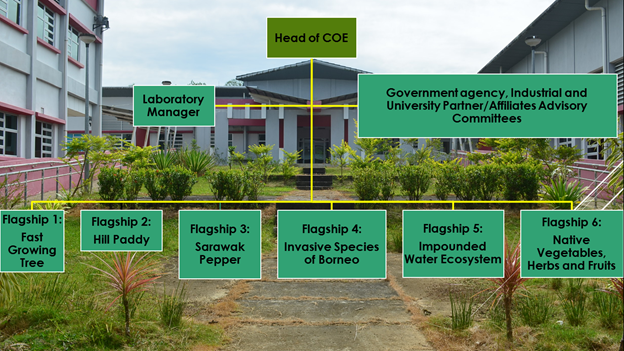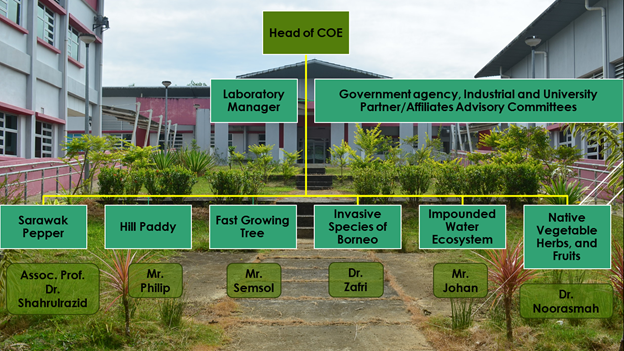

Flagship 1: Sarawak Pepper (Associate Prof. Dr. Shahrul Razid Sarbini)
- Sarawak Pepper, being the first agriculture product to be registered under GI in Malaysia requires stringent control of its quality from the farm level to the export level. Amongst the quality parameters that MPB focus on are microbial load of the pepper and presence of extrinsic chemical properties that include pesticides residues, trace metals (trace/ultra-trace heavy metal) and mycotoxin. This raised a major concern that need to be addressed as pepper (Piper nigrum L.) cultivation intensified and banned of open burning in farm practices, disease problems were observed, thus the use of pesticides has greatly increased.
- Root-knot nematodes (Meloidogyne spp.) attack the roots and wrinkled leaf disease, caused by viruses, affects both young and mature vines. Protection against nematode in pepper farming is chiefly by chemical means, which not only incurs a significant cost of production in pepper, as well as possible trace of pesticide in pepper products. The recoveries of pesticides have been reported in Thailand pepper, among the pesticide residues are Pyrethroids, Carbendazim, Carbamates, Cypermethrin, Chlorpyrifos, Carbaryl and Organophosphates. Therefore, one of the major challenges faced by the pepper industry is to produce peppercorn with the lowest levels of pesticide residues. In order to meet stringent food safety regulations for human consumption, the Codex Alimentarious Commission has set the Maximum Residue Limits (MRL) at 1 mg kg−1 for DDT; 0.5 mg kg−1 for λ–cyhalothrin, fenvalerate, deltamethrin; 0.1 mg kg−1 for permethrin, cyfluthrin, cypermethrin, heptachlor and 5 mg kg−1 for endosulfan in peppercorn.
- In this study, we will aim to address the pest and disease issues in pepper farming and use of chemical control. There are three main objectives: (1) To establish the severity index of the pepper economy losses due to nematode attack through field census and pepper yield correlation (2) To improve effectiveness of biocontrol agent, Paecilomyces lilacinus by strain selection in controlling nematode, Meloidogyne igconita. (3) To determine the optimum dosage, application methods and interval time (spraying regime) of biopesticide Paecilomyces lilacinus in controlling Meloidogyne igconita. (4) To formulate artificial diet for Meloidogyne igconita to facilitate the nematode biocontrol research.
Flagship 2: Hilly Paddy (Mr. Philip Lepun)
- Swidden agriculture or shifting cultivation is one of the main subsistence agriculture activities of rural population mainly in tropical forest countries.
- This system has been practiced for thousands of years and is the dominant land use system in the mountainous regions.
- The swidden agriculture leads to the formation of mosaics of secondary forests in different stages of regeneration, contained within a mature forest matrix that helps to sustain.
- The swidden agriculture appears to maintain the genetic diversity of the crops and secondary forests in regeneration processes that consequently exhibit ecological sustainability elements. The period of disturbance is compensated by the recovery of the soil-vegetation system.
- However, there is very limited information on swidden agriculture especially on agronomic aspects, geographical and demographic data on the relationship of hill paddy varieties and yield with soil types and the socio-economic and biophysical effects of the transformations of swidden agriculture practices.
COE Borneo EkoSains Research focuses are:
- Building database on hill paddy varieties in relations with ethnic groups and land use system of tropical forests.
- Evaluate the sustainability of the forest regeneration system based on soil physical, chemical and biological characteristics, hill paddy growth performance, diseases tolerant, yield and nutritional profiling.
Flagship 3: Fast Growing Tree (Mr. Semsolbahri Bokhari)
- Nowadays, the global demand and supply of wood from forest plantations is projected to continuously increase in the decades. In fact, Malaysia is facing the shortage of wood in both plantation and natural forest. Thus, the government are looking for fast growing tree to solve this issue in future stocks. The fast growing trees give plantation owners a significant head start on their timber investment by cutting time to harvest in half, an important consideration for timber investors looking for a return on their investment as quickly as possible.
- Our research focus is to seek and study the potential wood species as fast growing trees for forest plantation and to sustain wood production and determine their quality.
- Research study fields include wood anatomy, wood products, wood properties, biodiversity of planted forest, soils and fertilizers, hydrology properties, forest rehabilitation, wildlife management and socio economy impact. The sub-topic of study as follow:
- Species identification and introducing the hybrid species for forest plantation
- Anatomical and morphology aspect of identified species.
- Determine the fertilizing system and methods
- Evaluate the suitability of habitat, soils and fertilizers
- Determine the wood properties for downstream products.
- Impact of ecosystem and hydrological properties in planted forest
- Collecting and propagation seed
- Examine the distribution of mammals and birds in the planted forest
- Impact of socio-economy
Flagship 4: Invasive Species (Dr. Mohd Zafri Hassan)
- Species invasion is one of the leading issues that threats biodiversity.
- Borneo, as one of the biodiversity hotspots in the world, particularly Sarawak, is potentially facing that challenge with translocations of non-native species into its ecosystem through increased human activities in sectors such as agriculture, and aquaculture.
- Invasive species are characteristically known to quickly adapt to their new environments to the point of outcompeting and displacing native species. If mitigation efforts are ignored, invasion would result in reduced heterogeneity in species distribution and loss of ecosystem services provided by native species.
- The “Invasive Species in Borneo Research Group” of Center of Excellence for Borneo Eco-science of Faculty of Agriculture and Food Sciences will spearhead the research; with interest in focusing its research directions on modes of entry, expansion range, inter-specific interactions and socio-economic impacts.
Flagship 5: Impounded Water Ecosystem (Mr. Johan Ismail)
- Sarawak plans to harness the high annual rainfall and an abundance of rivers by using hydroelectric power to produce alternative renewable energy source. Under the SCORE development plan, Sarawak plans to have 11 hydropower electric dams (HEP) inclusive of 3 completed HEP projects: Murum HEP (2015), Bakun HEP (2011) and Batang Ai HEP (1985). Baleh HEP is the latest upcoming project that has been approved by the state government in 2016. These projects will require huge areas of land/forest that will be flooded. The total reservoir area of the 3 completed HEPs (1025 km2) at full water capacity is approximately 1.5 times larger than the size of Singapore (719 km2). The catchment area of the 3 completed HEPs is larger than the state of Selangor.
- While these projects will be highly profitable to the state government, local industry and environment as it’s producing sustainable “clean” energy, major ecosystem need to be monitored to minimise the possible disruption caused during the development phase mainly by flooding of land/forest and displacement of local communities.
- Batang Ai has been recognized for orang utan conservation and production of tilapia while Kenyir Lake has been a popular ecotourism and a sanctuary for ikan Kelah. Another HEP, the Temenggor lake is recognised for the occurrence of rafflesia, kenyalang, tapir in its forest and the Belum Rainforest Reserve within its area, The Pulau Banding Foundation was set up in Temenggor HEP and has collaboration with universities, build a dedicated research center within the area for conservation and research. In this regard, universities, and communities can play a significant role in the long term development plan of HEP in Sarawak.
- The primary stakeholder for this program will be Sarawak Energy Board (SEB). UPMKB have the academic specialty and strategic opportunity to collaborate with SEB to undertake various projects under this program.
- This is a multi-disciplinary projects that covers biodiversity of flora and fauna, water quality and hydrology, aquatic biology, toxicology, gaseous emission, soil science, microbiology, community empowerment, social studies, geographical information system, aquaculture potentiality, eco-tourism and many others.
- Our collaboration with Sarawak Government and SEB will give special focus on knowledge transfer and community empowerment in HEPs while emphasising conservation of our valuable natural resources.
Flagship 6: Native Vegetable, Herb and Fruit (Dr. Noorasmah Saupi)
- There are many well-known vegetables and fruits in Malaysia and at the same time many plants are also less known or less utilized or considered rare and also natively found in certain localities. The native vegetables and fruits available in natural environment possess high nutritive value such as carotene, riboflavin, folic acid, calcium, iodine, vitamin A, zinc, iron and phosphorous which can nourish the ever increasing human population. Generally, these vegetables and fruits are usually limited to kitchen gardens for household consumption and production only for local. Some are not cultivated at all but collected when needed from the forest, common ground or waysides. Many wild plants used in industrialized countries today were originally identified and developed through indigenous knowledge. In Southeast Asia about 100 species of the 225 vegetables are weeds or wild plants. Recently, only about 300 species native to the country have been exploited and utilized.
- In Malaysia, various native foods are available seasonally but not utilized to the extent they should be in spite of their high nutritive value. Native vegetables and fruits gathered from the wild for own consumption and are also offered for sale at native markets locally known as tamu. The presence and absence of wild food plants used by households can be documented at the food markets. Those vegetables and fruits are commonly consumed in rural areas but once offered for sale in the native markets, they are made available to the urban people. Despite the uses of them as food and medicinal purpose by the local people, native plants have not been given due attention in terms of their propagation modes, medicinal and nutritional content.
- For this reason, this cluster group will be conducted various aspect of studies to elaborate the potential of native plant species as a food and medicinal crops such as ethnobotany, plant biology and ecology, nutritional and medicinal value study, agronomy and marketing study. It is hope that the information would be used for advocating their increased utilization and commercialized for new food crops.





























